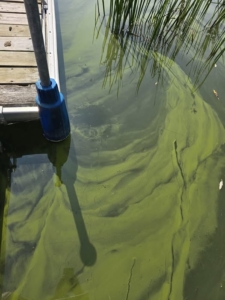China Lake Assn. members hear about water quality
 by Jonathan Strieff
by Jonathan Strieff
Nearly 80 community members gathered in the China Primary School gymnasium on July 29 for the annual China Lakes Association meeting. After a welcome and networking breakfast catered by Sunrise Bagels, CLA president, Stephen Greene, introduced three guest speakers from the Department of Environmental Protection, Ecological Instincts, and the Kennebec Water District to speak to the current health of China Lake.
The overall message was that, while water quality has greatly improved in recent years, China Lake remains an “impaired” body of water, supporting nuisance algae blooms, and with the deepest parts of the lake continually reaching an anoxic (oxygen deprived) state inhospitable to aquatic life. “There’s lots of work,” Greene said in his opening remarks, “all of you can do to make a difference, ensuring the sustainability of the watershed for the next generation, and spreading the serious message about the improvements needed to protect our very very beautiful lake.”
The keynote address was delivered by Wendy Garland, director of Maine DEP. She began her presentation by referring to the infamous status of “China Lake Syndrome,” a broad term for persistent nuisance algae blooms resulting from high levels of phosphorus entering the lake due to rapid shoreline development. The internal cycling of phosphorus in the watershed from has led to the sharp decline in both water clarity and the cold water fishery. The internal phosphorus load, having accumulated in the lakebed sediment from decades of runoff and erosion, is primarily responsible for the algae blooms and is being targeted for inactivation in the 2022-2031 China Lake Watershed-Based Management Plan. The effectiveness of the plan depends on reducing the external phosphorus load entering the lake annually through nonpoint source pollution.
According to the WBMP, internal phosphorus inactivation can be achieved using alum, or non dissolved aluminum, to bind the elements in the surface sediments and make them less susceptible to release. Garland identified grant funding for the project available from section 319 of the Clean Water Act and LD 164, An Act to Fund Lake Restoration and Protection.” Unfortunately, before its passage, LD 164 was scaled back from $2.5 million to $200,000.
“No one at DEP is currently allowed to speak in public without mentioning PFAS,” Garland joked towards the end of her presentation.
Levels of PFAS, a class of “forever chemicals” known to cause serious health problems, were found to be high enough in tissue samples from small mouth bass, large mouth bass, and perch caught in China Lake for DEP to revise its guidelines, from consuming no more than two meals of caught fish per month down to one per month.
In closing, Garland offered an inspirational message to those present, to help redefine China Lake Syndrome as a positive example of how collaborative efforts from dedicated stakeholders can restore water quality to previously impaired lakes and streams.
Next, Jen Jesperson, of Ecological Instincts, an environmental consulting firm responsible for the WBMP presented a an update from the first year of the plan’s implementation. Jesperson articulated that the goal of ending algae blooms was still a long way off, but not impossible. Water clarity in 80 percent of the lake stands at less than two meters deep. More than 60 percent of the lake is considered anoxic, with dissolved oxygen levels at or near zero parts per million.
The goals of the WBMP are to reduce phosphorus levels from 17 parts per billion to 13 ppb in the west basin and 10 ppb in the east basin by 2031. The alum treatment scheduled for 2026 will do a lot to reach these goals but much still depends on controlling the external phosphorus load entering the watershed.
The final guest speaker was Robert Bickford, the water quality manager of the Kennebec Water District. Bickford reiterated many of the earlier points about the current health of the China Lake watershed and offered detailed technical information about the ongoing water quality monitoring performed by KWD.
The gathering also heard from CLA director, Bill Powell about the annual loon count, elected new officers and directors, and received the financial report from CLA treasurer Natasha Littlefield.
Those interested in learning more about the WBMP or about proactive measures to help mitigate erosion and runoff pollution in the lake can visit www.chinalakeassociation.org or www.lakes.me.
Responsible journalism is hard work!
It is also expensive!
If you enjoy reading The Town Line and the good news we bring you each week, would you consider a donation to help us continue the work we’re doing?
The Town Line is a 501(c)(3) nonprofit private foundation, and all donations are tax deductible under the Internal Revenue Service code.
To help, please visit our online donation page or mail a check payable to The Town Line, PO Box 89, South China, ME 04358. Your contribution is appreciated!





Leave a Reply
Want to join the discussion?Feel free to contribute!